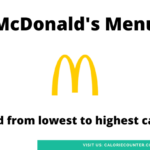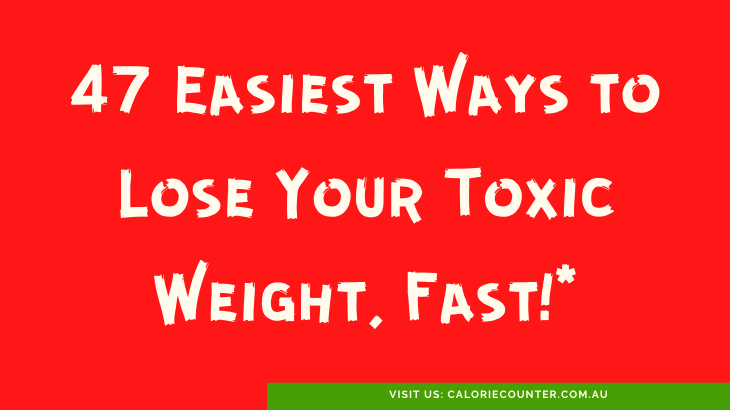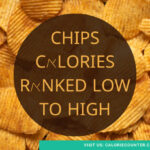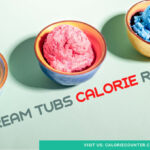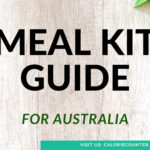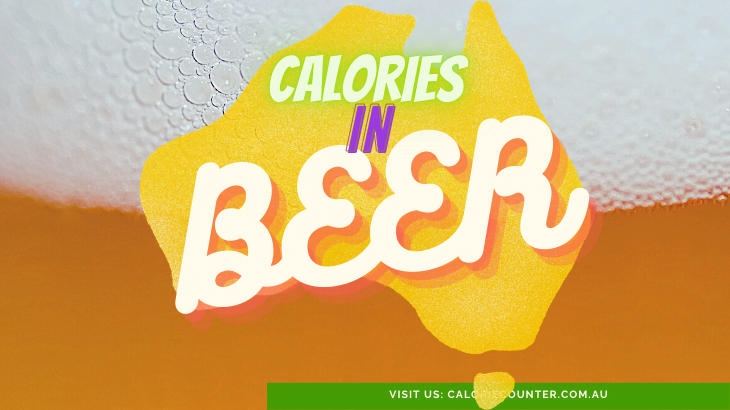There are 160 calories in 250ml (one cup) of Full Cream Milk, compared to 112.5 calories in Lite milk, and 87.5 calories in Skimmed Milk. When you are tracking your calories, which is the better choice: full-cream milk, “lite” milk, or skimmed milk? Is it true that reduced-fat milk is just watered-down whole milk?
Before you rush in with a quick “Its obvious!” answer, let us take a closer look at these three options…
How do they make reduced fat milk?
In pre-industrial times, skimmed milk was simply whole milk whose cream was removed by skimming off the top after it was left to settle in a pail. We do things a bit differently these days!
To make reduced fat milk, pre-processed whole milk from a blend of different cows is spun around in a specialised centrifuge. The centrifugal force breaks the milk into its separate components of water, fat, carbohydrates, protein, minerals, and vitamins. The manufacturer then reprocesses the separate ingredients in different batches and proportions to make different types of dairy products.
It is Centrifuged!
If you have read our post on panela, you will have found out that centrifuges are incredibly useful food-processing machines.
Reduced-fat milk is theoretically just recombined whole milk, without all the fat added back.
Whole milk has a generally accepted fat content of 3.5%, but of course in nature this varies immensely depending on the cow breed, the cow’s diet, the relative water content, and a hundred other input variables.
Full-Cream Milk Fat Percentage, compared to Low-Fat (Lite) and Skimmed Milk
Manufacturers carefully standardise the fat content of full-cream milk at 3.5%.
Different countries have various regulations which determine what can and cannot be called “skimmed milk” and “reduced fat milk”. In Australia, milk must have a fat content of less than 0.15% before it can be marketed as Skimmed Milk or “Fat-Free”.
Reduced Fat Milk must have at least 25% less fat than whole milk.
Low-Fat Milk (also marketed as “Lite” or “Light” milk) must have less than 1.5% fat by composition.
Milk Nutrition Comparison Chart
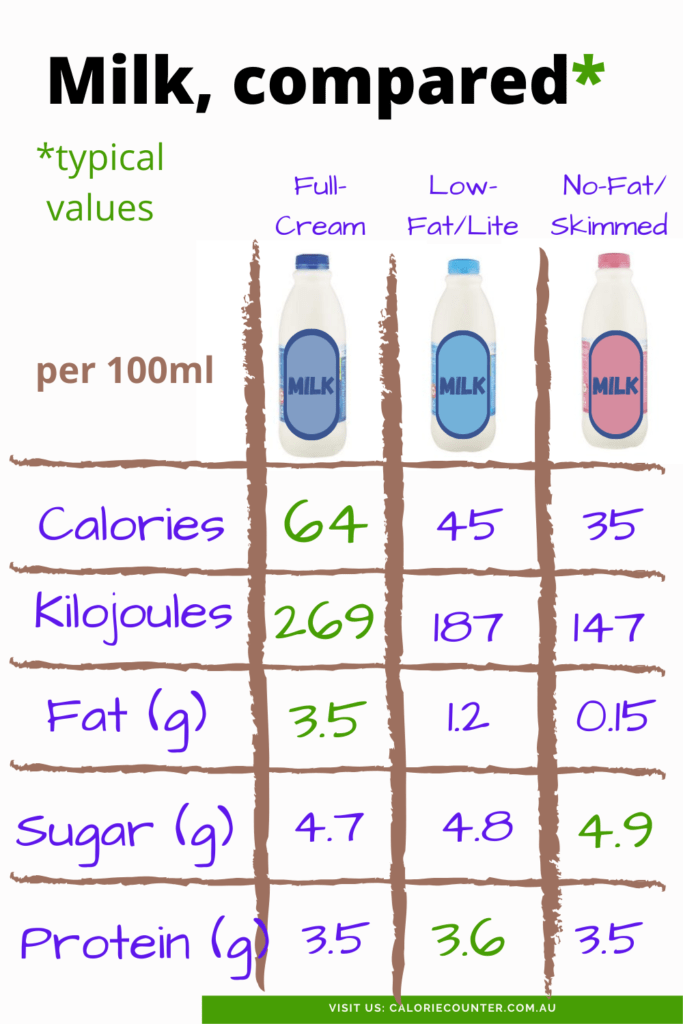
There is more Sugar in Skimmed Milk
Back up a little and think about how they make reduced fat milk: the fat is physically taken out. What happens when you take one specific thing out of a mixture? Everything else, including the sugar, becomes relatively more concentrated! It is like simmering sugar water on your stovetop to make syrup.
A typical full-cream milk is 4.7% sugar, whilst a typical skimmed milk is 4.9% sugar, compared to 4.8% for low-fat milk.
This sugar difference (about 4%) has a noticeable effect on the taste of skimmed milk compared to full-cream milk.
In addition to there being more sugar in reduced fat milk, there is also more of everything else (except for fat!) like protein (mainly in casein form), minerals and vitamins.
Full-Cream Milk Calories
Full-cream milk has 45% more calories than skimmed milk, as a direct result of there being about 95% more fat in it. Low-fat milk by comparison has about 65% less fat and 30% less calories than full-cream milk.
A single small glass (250ml) of full-cream milk makes up about 8% of a 2,000 calorie daily diet, whereas that same glass of skimmed milk would comprise just 4% of the same diet.
Lots of Saturated Fat in Whole Milk
Everyone has probably heard that saturated fats, as opposed to unsaturated fats, are bad for you if eat too many. Saturated fats have been linked with a broad range of “first-world” health problems like heart disease. The World Health Organisation recommends that less than 10% of total energy intake should come from saturated fats.
Milk fat is typically 60% saturated fat! In a typical full-cream milk product, 2.1 grams of the 3.5grams of fat per 100ml is saturated fat. This means that drinking more than two small glasses of full-cream milk will quickly bring you up to the daily recommended limit. You would need to drink about 45 of the same glasses of skimmed milk to hit that same limit.
There is saturated fat in full-cream, lite, and skimmed milk, but in widely differing quantities.
Saturated Fat in Milk Comparison Chart
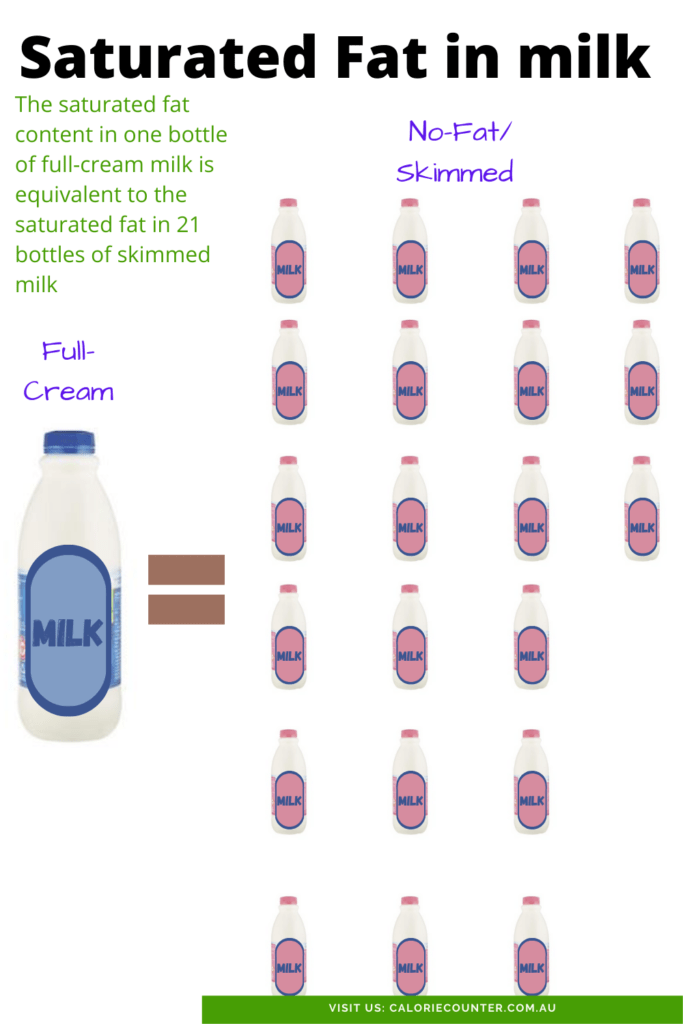
Of course, there are always dissenting voices supported by studies like this one which say that the saturated fat in milk has no adverse effect on health. As with many contentions related to health and food, it may be many years before we reach the unassailable truth.
Read the label!
If you are serious about nutrition, it is a good idea to base your milk choice on what you see on the food label. The nature of milk means that there is an enormous amount of variation between types and brands of milk. Manufacturers have a lot of leeway when it comes to what they put in and take out of the product known as milk.
Other than the broad percentage-based government guidelines, reduced-fat milk could be anything from 75% full-cream to 0% full-cream. Lite milk could have as much as 1.5% or as little as 0.15% fat – the difference is a factor of 10!
Which Milk is Better for You?
Finally, a simple conclusion: Skimmed Milk beats Lite Milk beats Full-Cream Milk because less calories, less saturated fats, more nutrients.
Reduced-fat milks do not taste as good as full-cream milk because they have less fat in them, not because they are “watered-down”. You will get excellent nutrition from skimmed milk, don’t worry.
Yes, it was kind of obvious.
Check out this video from Dairy Australia about how milk is manufactured:


